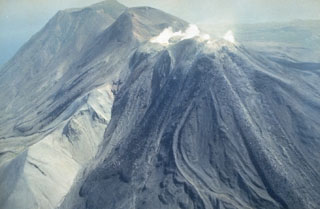Report on Moyorodake [Medvezhia] (Japan - administered by Russia) — 26 July-1 August 2017
Smithsonian Institution / US Geological Survey
Weekly Volcanic Activity Report, 26 July-1 August 2017
Managing Editor: Sally Sennert.
Please cite this report as:
Global Volcanism Program, 2017. Report on Moyorodake [Medvezhia] (Japan - administered by Russia) (Sennert, S, ed.). Weekly Volcanic Activity Report, 26 July-1 August 2017. Smithsonian Institution and US Geological Survey.
Moyorodake [Medvezhia]
Japan - administered by Russia
45.389°N, 148.838°E; summit elev. 1124 m
All times are local (unless otherwise noted)
The Institute of Volcanology and Geodynamics (Russian Academy of Natural Science) reported that during the morning of 31 July volcanologists working on Kudryavy, a stratovolcano of the Medvezhia volcanic complex, noted a sharp increase in the volume of vapor-and-gas emissions, with a plume rising more than 1 km. The emissions rose from a new crater, Malysh, that was formed after the 1999 phreatic eruption. A significant increase in temperature (an average of 100 degrees Celsius) was measured at fumarolic sites, and new high-temperature areas were noted. Crusts of native sulfur at the boundaries of high-temperature areas were melting and burning. Two people at the top of the volcano and workers at the main base camp (3.5 km S) self-evacuated.
The report noted that a M 5.7 earthquake had occurred at 0800 that same morning, 200 km NE, within the same system of tectonic faults that the volcano resides on. The volcano has a permeable system of fissures, through which there has been constant degassing for more than 130 years.
Geological Summary. The Moyorodake volcanic complex (also known as Medvezhia) occupies the NE end of Iturup (Etorofu) Island. Two overlapping calderas, 14 x 18 and 10 x 12 km in diameter, were formed during the Pleistocene. The caldera floor contains several lava domes, cinder cones and associated lava fields, and a small lake. Four small closely spaced stratovolcanoes were constructed along an E-W line on the eastern side of the complex. The easternmost and highest, Medvezhii, lies outside the western caldera, along the Pacific coast. Srednii, Tukap, and Kudriavy (Moyorodake) volcanoes lie immediately to the west. Historically active Moyorodake is younger than 2000 years; it and Tukap remain fumarolically active. The westernmost of the post-caldera cones, Menshoi Brat, is a large lava dome with flank scoria cones, one of which has produced a series of young lava flows up to 4.5 km long that reached Slavnoe Lake. Eruptions have been documented since the 18th century, although lava flows from cinder cones on the flanks of Menshoi Brat were also probably erupted within the past few centuries.
Source: Institute of Volcanology and Geodynamics, Russian Academy of Natural Science

